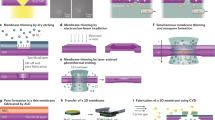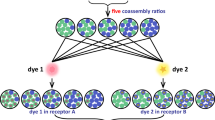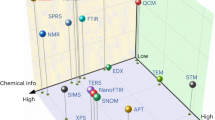Abstract
Nanoplasmonic structures designed for trace analyte detection using surface-enhanced Raman spectroscopy typically require sophisticated nanofabrication techniques. An alternative to fabricating such substrates is to rely on self-assembly of nanoparticles into close-packed arrays at liquid/liquid or liquid/air interfaces. The density of the arrays can be controlled by modifying the nanoparticle functionality, pH of the solution and salt concentration. Importantly, these arrays are robust, self-healing, reproducible and extremely easy to handle. Here, we report on the use of such platforms formed by Au nanoparticles for the detection of multi-analytes from the aqueous, organic or air phases. The interfacial area of the Au array in our system is ≈25 mm2 and can be made smaller, making this platform ideal for small-volume samples, low concentrations and trace analytes. Importantly, the ease of assembly and rapid detection make this platform ideal for in-the-field sample testing of toxins, explosives, narcotics or other hazardous chemicals.
This is a preview of subscription content, access via your institution
Access options
Subscribe to this journal
Receive 12 print issues and online access
$259.00 per year
only $21.58 per issue
Buy this article
- Purchase on Springer Link
- Instant access to full article PDF
Prices may be subject to local taxes which are calculated during checkout





Similar content being viewed by others
Change history
27 November 2012
In the version of this Article originally published online, in Fig. 1a, the second item in the legend should have read 'MGITC in organic phase'. In Fig. 1b, the fourth item in the legend should have read 'Organic phase'. These errors have been corrected in all versions of the Article.
19 December 2012
In the version of this Article originally published online, in Fig. 1b panel vi, the units on the bottom two curves (red and yellow) should have read 'fmol'. These errors have been corrected in all versions of the Article.
References
Lefevre, F. et al. Algal fluorescence sensor integrated into a microfluidic chip for water pollutant detection. Lab Chip 12, 787–793 (2012).
Byer, R. L. & Garbuny, M. Pollutant detection by absorption using mie scattering and topographic targets as retroreflectors. Appl. Opt. 12, 1496–1505 (1973).
Pushkarsky, M. B. et al. High-sensitivity detection of TNT. Proc. Natl Acad. Sci. USA 103, 19630–19634 (2006).
Sylvia, J. M., Janni, J. A., Klein, J. D. & Spencer, K. M. Surface-enhanced Raman detection of 2,4-dinitrotoluene impurity vapor as a marker to locate landmines. Anal. Chem. 72, 5834–5840 (2000).
Anderson, G. P. et al. TNT detection using multiplexed liquid array displacement immunoassays. Anal. Chem. 78, 2279–2285 (2006).
Kawano, R. et al. Rapid detection of a cocaine-binding aptamer using biological nanopores on a chip. J. Am. Chem. Soc. 133, 8474–8477 (2011).
Zhang, J. et al. Visual cocaine detection with gold nanoparticles and rationally engineered aptamer structures. Small 4, 1196–1200 (2008).
Liu, C. et al. Lateral flow immunochromatographic assay for sensitive pesticide detection by using Fe3O4 nanoparticle aggregates as color reagents. Anal. Chem. 83, 6778–6784 (2011).
Kneipp, K. et al. Single molecule detection using surface-enhanced Raman scattering (SERS). Phys. Rev. Lett. 78, 1667–1670 (1997).
Nie, S. & Emory, S. R. Probing single molecules and single nanoparticles by surface-enhanced raman scattering. Science 275, 1102–1106 (1997).
Liu, H. et al. Single molecule detection from a large-scale SERS-active Au79Ag21 substrate. Sci. Rep. 1, 112 (2011).
Xu, J. Y. et al. SERS detection of explosive agent by macrocyclic compound functionalized triangular gold nanoprisms. J. Raman Spectrosc. 42, 1728–1735 (2011).
Yang, L., Ma, L., Chen, G., Liu, J. & Tian, Z-Q. Ultrasensitive SERS detection of TNT by imprinting molecular recognition using a new type of stable substrate. Chemistry 16, 12683–12693 (2010).
Carter, J. C., Brewer, W. E. & Angel, S. M. Raman spectroscopy for the in situ identification of cocaine and selected adulterants. Appl. Spectrosc. 54, 1876–1881 (2000).
Bell, S. E. & Sirimuthu, N. M. Rapid, quantitative analysis of ppm/ppb nicotine using surface-enhanced Raman scattering from polymer-encapsulated Ag nanoparticles (gel-colls). Analyst 129, 1032–1036 (2004).
Shende, C., Gift, A., Inscore, F., Maksymiuk, P., Farquharson, S., 1st edn, (eds Bennedsen, B. S. et al.) SPIE Vol. 5271, 28–34 (2004).
Kelly, K. L., Coronado, E., Zhao, L. L. & Schatz, G. C. The optical properties of metal nanoparticles: The influence of size, shape, and dielectric environment. J. Phys. Chem. B 107, 668–677 (2002).
Yan, B. et al. Engineered SERS substrates with multiscale signal enhancement: Nanoparticle cluster arrays. ACS Nano 3, 1190–1202 (2009).
Chen, A. et al. Self-assembled large Au nanoparticle arrays with regular hot spots for SERS. Small 7, 2365–2371 (2011).
Cintra, S. et al. Sculpted substrates for SERS. Faraday Discuss. 132, 191–199 (2006).
Mahajan, S., Baumberg, J. J., Russell, A. E. & Bartlett, P. N. Reproducible SERRS from structured gold surfaces. Phys. Chem. Chem. Phys. 9, 6016–6020 (2007).
Dadosh, T. et al. Plasmonic control of the shape of the Raman spectrum of a single molecule in a silver nanoparticle dimer. ACS Nano 3, 1988–1994 (2009).
Kahl, M., Voges, E., Kostrewa, S., Viets, C. & Hill, W. Periodically structured metallic substrates for SERS. Sens. Actuat. B 51, 285–291 (1998).
Das, G. et al. Nano-patterned SERS substrate: Application for protein analysis versus temperature. Biosens. Bioelectron. 24, 1693–1699 (2009).
Vignolini, S. et al. A 3D optical metamaterial made by self-assembly. Adv. Mater. 24, OP23–OP27 (2012).
Hao, E. & Schatz, G. C. Electromagnetic fields around silver nanoparticles and dimers. J. Chem. Phys. 120, 357–366 (2004).
Yang, Z-L., Li, Q-H., Ren, B. & Tian, Z-Q. Tunable SERS from aluminium nanohole arrays in the ultraviolet region. Chem. Commun. 47, 3909–3911 (2011).
Grzelczak, M., Vermant, J., Furst, E. M. & Liz-Marza’n, L. M. Directed self-assembly of nanoparticles. ACS Nano 4, 3591–3605 (2010).
Liu, S., Zhu, T., Hu, R. & Liu, Z. Evaporation-induced self-assembly of gold nanoparticles into a highly organized two-dimensional array. Phys. Chem. Chem. Phys. 4, 6059–6062 (2002).
Boker, A., He, J., Emrick, T. & Russell, T. P. Self-assembly of nanoparticles at interfaces. Soft Matter 3, 1231–1248 (2007).
Santos, H. A. et al. Electrochemical study of interfacial composite nanostructures: Polyelectrolyte/gold nanoparticle multilayers assembled on phospholipid/dextran sulfate monolayers at a liquid–liquid interface. J. Phys. Chem. B 109, 20105–20114 (2005).
Du, K., Glogowski, E., Emrick, T., Russell, T. P. & Dinsmore, A. D. Adsorption energy of nano- and microparticles at liquid–liquid interfaces. Langmuir 26, 12518–12522 (2010).
Pickering, S. U. Emulsions. J. Chem. Soc. D 91, 2021 (1907).
Gordon, K. C., McGarvey, J. J. & Taylor, K. P. Enhanced Raman scattering from liquid metal films formed from silver sols. J. Phys. Chem. 93, 6814–6817 (1989).
Oh, M. K., Yun, S., Kim, S. K. & Park, S. Effect of layer structures of gold nanoparticle films on surface enhanced Raman scattering. Anal. Chim. Acta 649, 111–116 (2009).
Li, Y-J., Huang, W-J. & Sun, S-G. A Universal approach for the self-assembly of hydrophilic nanoparticles into ordered monolayer films at a toluene/water interface. Angew. Chem. Int. Ed. 45, 2537–2539 (2006).
Luo, M. X., Song, Y. M. & Dai, L. L. Effects of methanol on nanoparticle self-assembly at liquid–liquid interfaces: A molecular dynamics approach. J. Chem. Phys. 131, 194703 (2009).
Su, B. et al. reversible voltage-induced assembly of Au nanoparticles at liquid–liquid interfaces. J. Am. Chem. Soc. 126, 915–919 (2003).
Flatté, M. E., Kornyshev, A. A. & Urbakh, M. Electrovariable nanoplasmonics and self-assembling smart mirrors. J. Phys. Chem. C 114, 1735–1747 (2010).
Sauer, G., Brehm, G. & Schneider, S. Preparation of SERS-active gold film electrodes via electrocrystallization: Their characterization and application with NIR excitation. J. Raman Spectrosc. 35, 568–576 (2004).
Kumar, G. V. P. et al. Hot spots in Ag core-Au shell nanoparticles potent for surface-enhanced raman scattering studies of biomolecules. J. Phys. Chem. C 111, 4388–4392 (2007).
Jing, C. & Fang, Y. Experimental (SERS) and theoretical (DFT) studies on the adsorption behaviors of l-cysteine on gold/silver nanoparticles. Chem. Phys. 332, 27–32 (2007).
Khaing Oo, M. K., Chang, C-F., Sun, Y. & Fan, X. Rapid, sensitive DNT vapor detection with UV-assisted photo-chemically synthesized gold nanoparticle SERS substrates. Analyst 136, 2811–2817 (2011).
Turek, V. A. et al. Plasmonic ruler at the liquid–liquid interface. ACS Nano 6, 7789–7799 (2012).
Turkevich, J. A study of the nucleation and growth processes in the synthesis of colloidal gold. Discuss. Faraday Soc. 11, 55–75 (1951).
Frens, G. Controlled nucleation for the regulation of the particle size in monodisperse gold suspensions. Nature 241, 20–22 (1973).
Liu, X., Atwater, M., Wang, J. & Huo, Q. Extinction coefficient of gold nanoparticles with different sizes and different capping ligands. Colloids Surf. B 58, 3–7 (2007).
Cecchini, M. P., Stapountzi, M. A., McComb, D. W., Albrecht, T. & Edel, J. B. Flow-based autocorrelation studies for the detection and investigation of single-particle surface-enhanced resonance Raman spectroscopic events. Anal. Chem. 83, 1418–1424 (2011).
Cecchini, M. P. et al. Ultrafast surface enhanced resonance Raman scattering detection in droplet-based microfluidic system. Anal. Chem. 83, 3076–3081 (2011).
Acknowledgements
We are grateful to A. Kucernak (Imperial College), M. Urbakh (University of Tel Aviv) and S. Goodchild (DSTL) for illuminating discussions and inspiration. A.A.K. and J.B.E. thank the DSTL for financial support of this project. This work was also financially supported in part by an ERC starting investigator grant to J.B.E. and an EU FP7 ‘Nanodetector’ grant (NMP4-SE-2012-280478) to A.A.K.
Author information
Authors and Affiliations
Contributions
M.P.C., V.A.T., J.P., A.A.K. and J.B.E. designed the experiments, wrote the paper and analysed the results. M.P.C., V.A.T. and J.B.E. performed the experiments.
Corresponding authors
Ethics declarations
Competing interests
The authors declare no competing financial interests.
Supplementary information
Supplementary Information
Supplementary Information (PDF 1366 kb)
Rights and permissions
About this article
Cite this article
Cecchini, M., Turek, V., Paget, J. et al. Self-assembled nanoparticle arrays for multiphase trace analyte detection. Nature Mater 12, 165–171 (2013). https://doi.org/10.1038/nmat3488
Received:
Accepted:
Published:
Issue Date:
DOI: https://doi.org/10.1038/nmat3488
This article is cited by
-
Combining surface-accessible Ag and Au colloidal nanomaterials with SERS for in situ analysis of molecule–metal interactions in complex solution environments
Nature Protocols (2023)
-
General approach to surface-accessible plasmonic Pickering emulsions for SERS sensing and interfacial catalysis
Nature Communications (2023)
-
Lossless enrichment of trace analytes in levitating droplets for multiphase and multiplex detection
Nature Communications (2022)
-
Quantitative SERS sensor based on self-assembled Au@Ag heterogeneous nanocuboids monolayer with high enhancement factor for practical quantitative detection
Analytical and Bioanalytical Chemistry (2021)
-
In-situ growth of gold nanoparticles on electrospun flexible multilayered PVDF nanofibers for SERS sensing of molecules and bacteria
Nano Research (2021)



